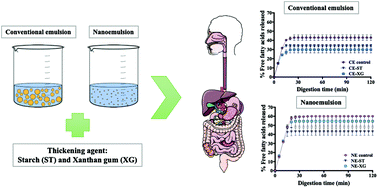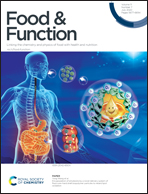Influence of the particle size and hydrocolloid type on lipid digestion of thickened emulsions
Abstract
Hydrocolloids are used as stabilizing agents in order to enhance the physical stability of emulsions during their storage. However, they can also play an important role in nutrient release and bioavailability. In this context, the aim of this research was to study the effect of the emulsion type and thickener type on the physical–structural changes and free fatty acid release during in vitro digestion. Oil-in-water emulsions were prepared with different particle sizes (CE: conventional emulsions and NE: nanoemulsions) and thickening agents (starch and xanthan gum). The experimental conditions of homogenization used allowed food emulsions to be obtained at the microscale and nanoscale, with particle sizes ranging among 3.2–3.4 μm and 78–107 nm for CE and NE, respectively. The addition of thickening agents (XG and ST) modified the physical properties of emulsions (particle size, zeta potential and stability) slightly, and thickened samples with similar viscosity were obtained. The kinetics of FFAs released during the in vitro intestinal digestion showed no significant differences (p > 0.05) in the digestion rate among samples; however, emulsion and thickener types decreased the final extent of free fatty acids, being more evident for those samples with starch. Xanthan gum kept the particle size of nanoemulsions stable during the oral and gastric phases, which promoted the release of FFAs during the intestinal phase. Therefore, xanthan gum could be used as a thickening agent of nanoemulsions exerting a minor impact on their lipid bioaccessibility.

- This article is part of the themed collection: 8th International Symposium on Delivery of Functionality in Complex Food Systems (DOF 2019)


 Please wait while we load your content...
Please wait while we load your content...